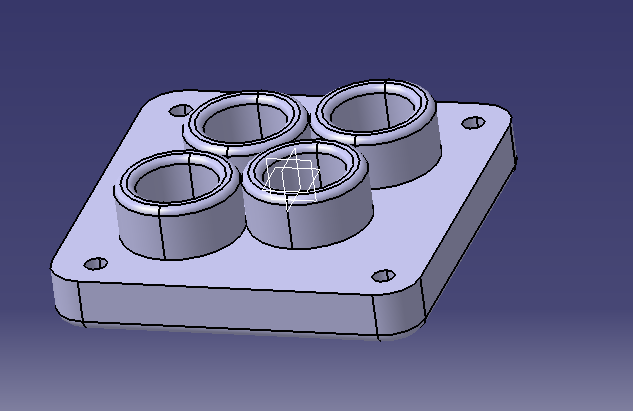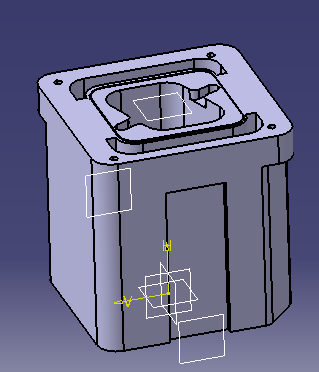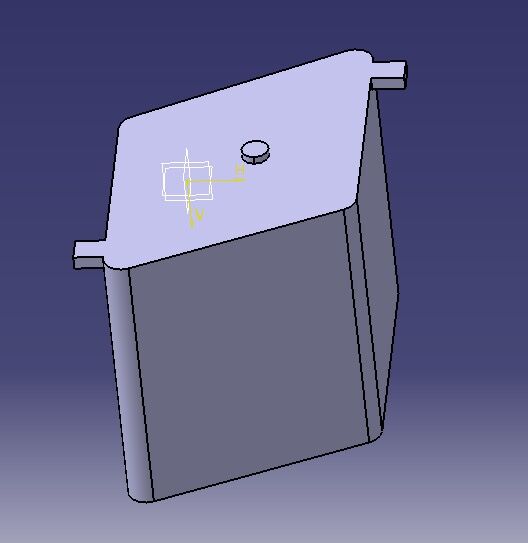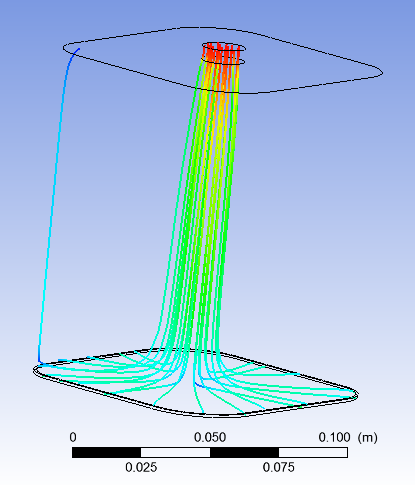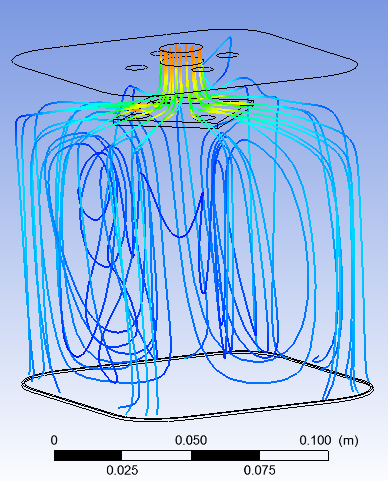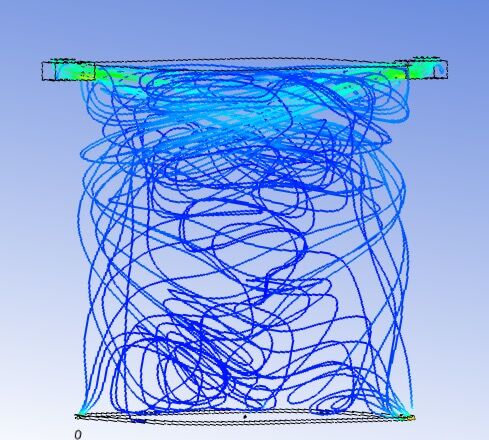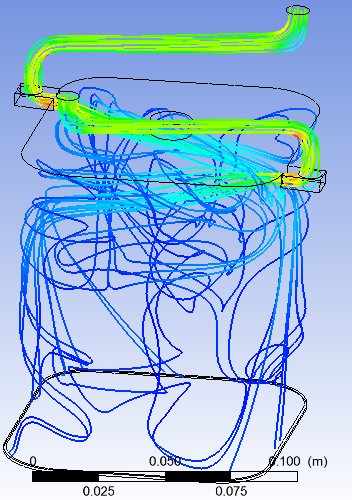重载汽车刹车系统超声检测传感器结构优化设计研究毕业论文
2020-02-17 19:29:46
摘 要
汽车制动系统的制动情况对机动车的行驶安全性具有十分的重要性尤其是对于无动力的拖挂型机动车。因此及时的对机动车进行安全隐患的无损检测就起着很重要的作用。目前而言前盘后鼓式刹车制动系统在国内多家汽车厂商的机动车方面均得到广泛应用,并存在着相当部分的车型依旧使用着四驱盘式制动系统。盘式制动器较鼓式制动器而言技术上领先了许多,总体结构更为轻量化,同整车的热量挥发性能、刹车制动性能及面对复杂天气与路况的适应性能得到了显著地提高。因此,本文主要探讨的是盘式制动器的相关研究项目。
制动器刹车时,液压或气压作用将两制动块向刹车盘压紧,制动效果的达成是通过制动块与刹车盘相互之间的摩擦力与摩擦力矩来达到的。
刹车盘工作时暴露在外界环境中,处于应力交替性变化状态,容易产生疲劳缺陷以及失效事故。因此刹车盘的强度要求与刚度要求是必须的,同时刹车盘外表面应有足够的耐磨度、工作时应该受力均匀、平衡性好。
往往造成制动事故的关键原因是盘式刹车盘产品本身存在的内部缺陷, 刹车盘内部缺陷通常表现为异物、分层、侧裂。
现阶段判断刹车盘内部缺陷的传统方法是采取一些有经验的工人师傅们的肉眼观察法和人工敲击法来判断是否存在内部缺陷,这种方法在国内大部分企业中均得到广泛性使用, 但是该检测方式的不足之处是过于依赖经验而且费时费力同时缺乏足够的准确度。所以研究新的刹车片检测方法, 因此提高刹车片的检测效率和精度是十分具有必要性的。
本文应用了水浸无损检测的方法来解决上述存在问题,来检测刹车盘的缺陷,并于以下几个方面进行了研究:
首先介绍了超声无损检测技术的国内外研究背景与发展历程,
其次,介绍了刹车盘常见的缺陷形式,并介绍了针对该刹车盘所设计出的水浸式超声无损探伤传感器结构,并针对该结构所设计的传感器水箱体结构的不同形式作出了不同的CATIA三维模型。
然后,将不同的传感器水箱体结构模型导入ANSYS-FLUENT板块进行内流场分析,得出了其流线流速三维图。
可以通过使用MATLAB软件来进行超声场的仿真并分析出水浸式超声检测技术的实际仿真过程从而提高水浸超声检测的可靠性。水浸超声检测探头传感器发射声场时的具体过程得以建立仿真。基于多元高斯声束理论从而对超声波的产生及其具体传播规律进行了分析与仿真,超声波的发射和传播过程得到描述,然后便是超声探头发射声场的仿真模型的成功设定,并基于不同水层厚度进行了不同的分析,最终得到数据。
关键词:盘式制动系统,水浸超声检测,内流场流体仿真,声场仿真。
Abstract:
The braking situation of the vehicle brake system is of great importance to the driving safety of the motor vehicle, especially for powered towing vehicles. Therefore, timely non-destructive testing of safety hazards on motor vehicles plays an important role. At present,
the front-disc drum brake system has been widely used in many domestic automobile manufacturers' motor vehicles, and there are still quite a few models that still use the four-wheel drive disc brake system. Disc brakes are technically superior to drum brakes, and the overall structure is lighter, and the thermal volatility of the vehicle, brake performance and
adaptability to complex weather and road conditions have been significantly improved. Therefore, this paper mainly discusses related research projects of disc brakes.
When the brake is braked, the hydraulic or pneumatic action presses the two brake pads against the brake disc, and the braking effect is achieved by the frictional force and the friction torque between the brake block
and the brake disc.
When the brake disc is exposed to the external environment during operation, it is in a state of alternating stress, which is prone to
fatigue defects and failure accidents. Therefore, the strength requirements and stiffness requirements of the brake disc are necessary. At the same time, the outer surface of the brake disc should have sufficient wear resistance, and the work should be evenly stressed and balanced.
The key cause of the brake accident is the internal defects of the disc brake disc product itself. The internal defects of the brake disc usually
show foreign matter, delam ination and side crack.
At present, the traditional method for judging the internal defects of the brake disc is to use some naked eyes and manual tapping methods of experienced workers to judge whether there are internal defects. This method has been widely used in most domestic enterprises. However, the
shortcoming of this detection method is that it is too dependent on experience and time-consuming and laborious, and lacks sufficient accuracy. Therefore, it is necessary to study the new brake pad detection method, so it is necessary to improve the detection efficiency and accuracy of the brake pad.
In this paper, the method of non-destructive testing of water immersion is applied to solve the above problems to detect the defects of the brake
disc, and the following aspects are studied:
Firstly, the research background and development history of ultrasonic
nondestructive testing technology are introduced.
Secondly, the common defect forms of the brake disc are introduced, and the structure of the immersion ultrasonic non-destructive testing sensor designed for the brake disc is introduced. Different forms of the sensor tank structure designed for the structure are made different. CATIA 3D model.
Then, different sensor tank structure models were introduced into the
ANSYS FLUENT section for internal flow field analysis, and a three-dimensional map of the streamline flow rate was obtained.
The MATLAB software can be used to simulate the ultrasonic field and analyze the actual simulation process of the immersion ultrasonic testing
technology to improve the reliability of the ultrasonic immersion ultrasonic testing. The specific process of the water immersion ultrasonic detection probe sensor when the sound field is emitted can be simulated. Based on the multivariate Gaussian sound beam theory, the generation of ultrasonic waves and its specific propagation law are analyzed and simulated. The process of ultrasonic wave emission and propagation is described, and then the successful setting of the simulation model of the sound field emitted by the ultrasonic probe is based on different water. The layer thickness was analyzed differently
and the data was finally obtained.
Key words: disc brake system, water immersion ultrasonic testing, internal flow field fluid simulation, sound field simulation
目录
第1章 绪论 1
1.1 引言 1
1.2 超声无损检测的研究背景 1
1.2.1 无损检测 1
1.2.2 超声无损检测 2
1.3 国内外的现状发展与趋势 3
1.3.1 国外发展状况简述 3
1.3.2 国内发展情况简述 4
1.3.3 超声无损检测技术的未来发展 4
1.4 文章的主体结构与内容安排 5
1.4.1 本文研究的主要内容 5
1.4.2 论文的全文布局安排 5
第 2 章 刹车盘及其缺陷设计 7
2.1 刹车盘相关介绍 7
2.2刹车盘结构 8
2.3水浸式超声无损检测传感器的结构 8
2.4刹车盘常见缺陷 10
2.5 刹车盘缺陷设计 11
2.6 本章小结 12
第 3 章 水浸超声传感器的内流场建模仿真 13
3.1 ANSYS FLUENT流体仿真软件的介绍 13
3.2 FLUENT应用特点 13
3.3 FLUENT软件适用范围: 14
3.4水浸式超声传感器水槽体不同方案的确立。 14
3.5建立并仿真不同模型的必要性。 14
3.6 不同内流场模型的建立与仿真分析。 15
3.6.1 单一喷头有遮板或无遮板的水浸式超声无损传感器 15
3.6.2 上置双入水口有缓冲管道与无缓冲管道的水浸式超声无损检测传感器。 17
3.6.3中上置双入水口有缓冲管道与无缓冲管道的水浸式超声无损检测传感器。 18
3.6.4中下置双入水口有缓冲管道与无缓冲管道的水浸式超声无损检测传感器。 19
3.6.5下置双入水口有缓冲管道与无缓冲管道的水浸式超声无损检测传感器。 20
3.6.6 对以上十组仿真的对照与总结: 21
3.7初始条件的设定与章节小结。 22
第 4 章 分布式超声无损检测有限元建模 23
4.1 声波与超声波 23
(1) 声波的传播性质即频率速度与周期: 23
(2)声阻抗 23
(3)超声波 23
4.2 超声波的发射与接收 24
4.3超声波检测技术 25
(1)脉冲反射法: 25
(2)穿透法 26
(3)共振法 26
4.3.1 超声波缺陷成像与传播控制方程 26
4.3.2 超声成像技术 26
4.4 超声波于介质内部传播过程中的传播方程 28
4.5 有限元计算 29
4.6 水浸式超声无损检测有限元建模 29
4.6.1 COMSOL介绍 29
4.6.2 定义刹车盘截面缺陷的平面模型 30
4.6.3 设置材料参数 32
4.6.4 物理场设定 33
4.6.5 定义有限元网格 34
4.7 结果分析 36
4.8 本章小结 41
第 5 章 缺陷成像算法研究 42
5.1 检测数据处理 42
5.2 MATLAB 编程与超声波频率谱选型 42
5.2.1 MATLAB介绍 42
5.2.2 无油孔模型缺陷成像及精度分析 44
5.3实验过程 46
5.3.1具体超声波频率对比 46
5.4 本章小结 52
第 6 章 总结与展望 53
6.1 本文总结 53
6.2 研究展望 53
参考文献: 54
致 谢: 55
附录: 55
第1章 绪论
引言
从2015年开始,我国汽车销量急剧增多,这也是我国从汽车大国转变成为汽车强国之路的典范,其中对于汽车安全装置的检测就显得十分重要,我国也逐渐提高了对于汽车安全系统的看重程度。
同时,因为中国正朝着汽车强国迈进,所以,汽车关键部件的检测,以及汽车的质量安全,也日益重要,这也是在汽车行业成为我国支柱型产业的必由之路。我们应大力提高对于汽车行业的支持力度。
同时,随着近几年,超声波技术的迅猛发展,它在工业生活中各个领域的应用也日渐广泛,我们对于超声波各种性质的研究也逐渐深入。
盘式制动系统中的刹车盘是影响汽车行驶安全性的关键部件之一,它在汽车制动过程中有着非常显著的影响。汽车的制动效能是由刹车盘的制动性能决定的。汽车的制动过程是通过液压将刹车块压向刹车盘,产生摩擦力与摩擦力矩。因此,刹车盘在工作环境中时常受到十分大的复合载荷的作用,如果刹车盘存在缺陷的话,在行驶过程中很容易造成巨大的安全事故与隐患,所以我们应该利用先进的超声无损检测技术来检测刹车盘的内部缺陷所在,来及时的避免安全隐患。
1.2 超声无损检测的研究背景
1.2.1 无损检测
通常情况下我们将不影响被测物体的固有状态而能够检测出固件内部内部缺陷的检测技术叫做无损检测技术,缺陷所引起的对热、声、光、电、磁等反应的变化可以通过对材料内部结构进行外源检测。
无损检测技术的显著性特点包括非破坏性,全面性,全程性和可靠性等特点。,这与其他破坏性检测形成了鲜明的特点。
以上是毕业论文大纲或资料介绍,该课题完整毕业论文、开题报告、任务书、程序设计、图纸设计等资料请添加微信获取,微信号:bysjorg。
相关图片展示:
